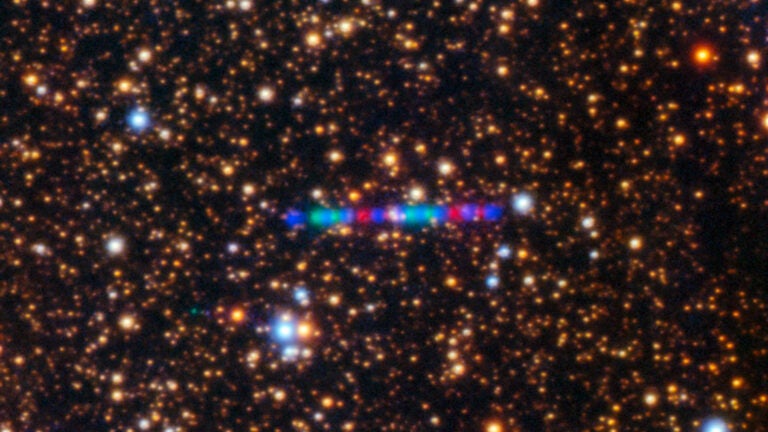Local News
Scientists who study comets are struggling to keep up with popular speculation that the interstellar object 3I/ATLAS was sent to our solar system by an alien intelligence.

Kim Kardashian excitedly quizzed the leader of NASA just before Halloween.
“Wait…. what’s the tea on 3I Atlas?!?!!!!!!!?????” she wrote on the social platform X.
Kardashian was inquiring about a comet called 3I/ATLAS that is swinging through our corner of the universe.
Sean Duffy, the acting administrator of NASA and himself a former reality television star, responded with encouragement, like a high school science teacher.
“Great question!” he said, explaining that “3I” labeled it as the third object known to have come from outside our solar system.
He reassured her that, whatever she might have heard about the comet’s possible origins, there was no reason to be alarmed.
“No aliens,” he said. “No threat to life here on Earth.”
This clump of rock, dust and ice, and whether it was sent by some intelligent beings, is suddenly a hot item on many people’s minds.
Kardashian asked about it. So did Joe Rogan on his podcast. A surge of people queried Google about NASA’s planetary defenses.
Andrew Siemion is the principal investigator for Breakthrough Listen, which is using large radio telescopes to search for extraterrestrial communications. He said he was at an airport recently when someone eavesdropping on his conversation “grabbed my shoulder and said, ‘Are you talking about 3I/ATLAS?’” He told the stranger that he was.
“People are aware of it,” Siemion said, “and people are very excited about it.”
The notoriety of this comet can be credited to Avi Loeb, a Harvard astrophysicist well regarded for his research on black holes, dark matter and other subjects of mainstream science.
But over the past few years, he has been speculating a lot about aliens, too.
Loeb has popped up on numerous news shows since July, when 3I/ATLAS was first spotted by the University of Hawaii’s Asteroid Terrestrial-impact Last Alert System (that’s the ATLAS in the name). He discussed the topic for a couple of hours with Rogan, and he has churned out a stream of essays asking whether the comet might be a Trojan horse sent by aliens to spy on Earth, or worse.
“Is 3I/ATLAS wearing a costume of a comet,” Loeb wrote recently, “or is it a truly icy rock of natural origin?”
He noted that on Dec. 19, six days before Christmas, the comet will make its closest pass to Earth, at a distance of about 170 million miles. “Will 3I/ATLAS send mini-probes towards Earth as Christmas gifts to humanity?” he asked.
Loeb puts the odds of an artificial origin for 3I/ATLAS at 30% to 40%. His argument hinges on seemingly unlikely coincidences and unusual characteristics observed in the comet.
That interpretation is in sharp contrast with those of many other scientists, who say they see no signs of anything unnatural.
“The whole subject is contaminated by this assertion that it might be a spacecraft,” said David Jewitt, an astronomer at UCLA. “So I think in people’s minds, you know, yeah, it’s a spacecraft.”
And, he added, when experts say that it is not, many people think that “they’re covering up.”
Everything that has been observed by both telescopes on the ground and in space “fits what we see in other comets,” Jewitt said. “It’s quite explainable, but Avi has systematically taken these things and interpreted them in a different way, to my disappointment.”
Loeb insists that he is open to changing his mind as more observations are made, but that he wants policymakers to take it seriously as a potential threat.
“What I’m saying is we should consider this possibility,” Loeb said in an interview.
A large audience shares Loeb’s willingness to consider that possibility, which combines an enduring philosophical question — “Are we alone in the universe?” — with conspiracy theories that experts and the government are hiding, or ignoring, the truth. (Kardashian first caught Duffy’s attention when she said on her show that she thought NASA had faked the Apollo moon landings.)
Science communication experts like Dan Fagin, director of the Science, Health and Environmental Reporting program at New York University, say that it is not necessarily bad for scientists to broach topics — like aliens — that understandably fascinate many people.
“It’s important to ignite scientific curiosity, including in people like Kim Kardashian,” Fagin said.
But, he added, “It is just as important, and arguably even more important, to talk about how likely something is, to talk about the probability as well as the possibility.”
Loeb admits that “30 to 40%” is an impression, not a scientific conclusion from statistical data. “It was not based on a calculation,” he said, “because it’s impossible to do a calculation on this.”
For the most part, 3I/ATLAS looks and behaves like a comet, made of the same stuff as run-of-the-mill comets in the solar system — water, dust, carbon dioxide and carbon monoxide. Hubble Space Telescope observations indicate that it is at most 3.5 miles wide, and Jewitt said it could be considerably smaller, perhaps two-thirds of a mile wide.
The comet does possess unusual properties. When it was discovered, more than 400 million miles from the sun, 3I/ATLAS was already surrounded by a cloud of dust and gas. That differs from the typical dark and inert state of most comets at that distance.
Some of its chemical composition has been off-kilter. It has much more carbon dioxide than most solar system comets, as well as high levels of nickel.
As 3I/ATLAS made its closest approach to the sun last month, it brightened considerably, and its color shifted, adding blue-green hues. Its trajectory is also not exactly what one would expect for something pulled just by the sun’s gravity.
As soon as 3I/ATLAS was discovered, Loeb began speculating about these oddities.
The nongravitational force nudging the comet and the blue-green hue could be the firing of a rocket engine, he has suggested. (Jets of gas shooting off the surface could provide a similar propulsive effect, and the color shift, which has been seen in other comets, could simply be the glow of molecules escaping the comet that are then excited by sunlight.)
Loeb has also highlighted how 3I/ATLAS is traveling in almost the same plane as the orbits of our solar system’s planets. The solar system is tilted at a 60-degree angle to the disc of the Milky Way galaxy, and thus the comet’s motion in the same plane as the planets could be another indicator that the trajectory is intentional, not random, he said.
But other astronomers say what Loeb sees as intentional design is most likely random chance. They also say that an object that formed around a different star and traveled across the Milky Way should be expected to look different.
“It came from outside of our solar system, for gosh sake,” Siemion said.
Whatever the comet’s source, its unusual properties could provide clues about distant parts of the Milky Way galaxy that scientists today will never be able to visit.
The carbon dioxide, for example, may be the result of billions of years of bombardment by high-energy cosmic rays that reshuffled the chemical bonds of carbon monoxide and water molecules.
“That’s telling us something really important about both how it formed and its journey,” said John Noonan, a planetary scientist at Auburn University.
Details on the specific isotopes of carbon, nitrogen and other elements could offer hints about what type of star 3I/ATLAS formed around.
After a month when 3I/ATLAS was unobservable from Earth because it was too close to the sun, it has come back into view as it speeds toward its exit from the solar system.
In the coming weeks, the James Webb and Hubble telescopes will make more observations.
A new U.S.-financed telescope in Chile, the Vera Rubin Observatory, will find many more interstellar objects in the coming years.
Kardashian has not publicly commented on whether Duffy, the leader of the government agency she says faked the moon landings, convinced her that 3I/ATLAS is not an invading alien spacecraft.
But Loeb has sassily invited her to join his research team.
This article originally appeared in The New York Times.



